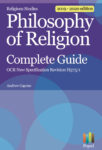STEP 1: Five steps to A grades
March 17, 2012
These steps are outlined in greater detail in the AS and A2 revision guides (above).
STEP 1: the DARM approach.
DARM is an acronym for analysing any moral theory. If we can answer these four questions, and also indicate some difficulties each theory faces when trying to answer them, we go a long way to developing A grade thinking.
D is for Derivation. How do our moral theories derive the idea of goodess? Goodness has to have content, we have to mean something when we say “generosity is good”. Kant derives “goodness” a priori, as a category of the mind which has the feature of universalisability. Aquinas derives it partly a priori, and partly a posteriori, a priori because synderesis (the innate desire to do good and avoid evil) is an a priori concept and partly a posteriori because the primary precepts are observable (by experience) rational ends which human beings pursue. So the first step is to go through every moral theory and answer this question – where does goodness come from? And what does it mean?
“generosity is good”. Kant derives “goodness” a priori, as a category of the mind which has the feature of universalisability. Aquinas derives it partly a priori, and partly a posteriori, a priori because synderesis (the innate desire to do good and avoid evil) is an a priori concept and partly a posteriori because the primary precepts are observable (by experience) rational ends which human beings pursue. So the first step is to go through every moral theory and answer this question – where does goodness come from? And what does it mean?
A is for Application. Having decided where goodness comes from and what it means, we then need to apply it to the moral issues listed in our syllabus. This isn’t quite as straightforward as we may think. For example, Kant asks us to universalise our actions and imagine what a world would be like where everyone in relevantly similar circumstances, did the same thing? Would we desire such a world? Would it be the best world to live in? Problem is, can we universalise an exception? For example, can we say “always tell the truth unless confronted by a madman with a knife”. Kantians disagree about how to answer this, and Kant himself felt we should “always tell the truth” without any exceptions.
R is for realism. What view of human nature is suggested by this theory, and is it realistic? For example, is Kant realistic in suggesting that reason and emotion should be separated, and that moral emotions don’t count. According to Kant the only motive that has moral worth is duty alone. Enjoying helping an old lady across the road has no moral worth. And utilitarians ask us to do calculations of a balance of pleasure over pain or happiness over misery. But when we don’t know the consequences, is it realistic to do a calculation?
M is for Motivation. How does our theory help to answer the question: why should I be moral? Why should I care about the happiness of others? Why not be a selfish egoist? Mill says, that as a matter of fact, we all feel sympathy for our neighbours. But suppose I don’t? Has Mill convinced me that I should care about my neighbours? And what about other theories? Why should I as a Natural Law follower obey the secondary precepts, particularly those that the Roman Catholic Church suggests, such as no contraception? Ultimately I have to agree that the Pope’s view of a flourishing life (eudaimonia in Greek) is the same as my view, and of course, they may not be. We need to tease out whether each theory has been successful in giving me a motive to be moral, and what that motive might be.
For a fuller guide to how to answer these four questions….read the revision guides!
Next week: part 2, building a scaffolding.
Cartoon: copyright Rebecca Dyer






0 Comments